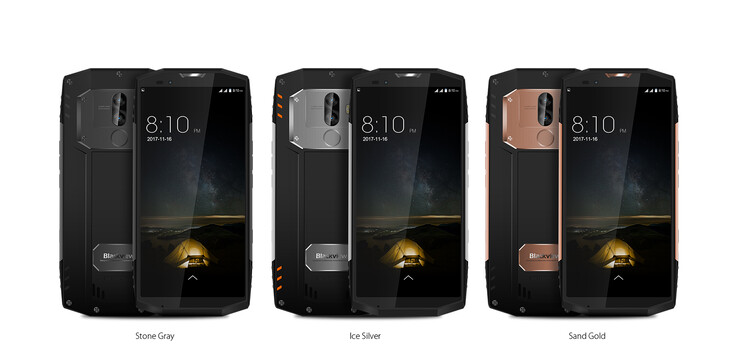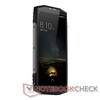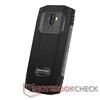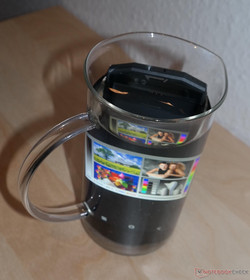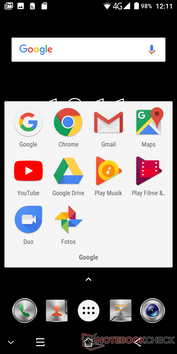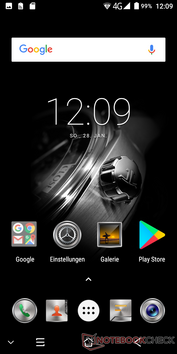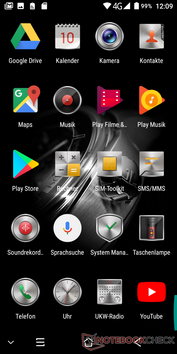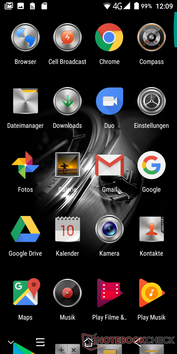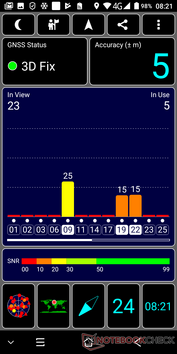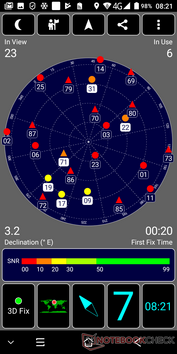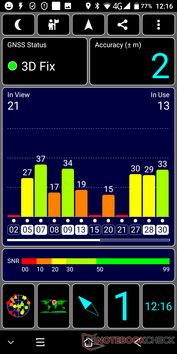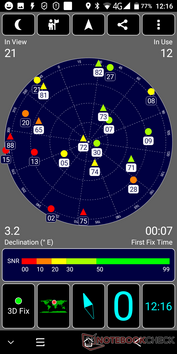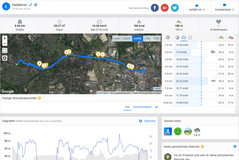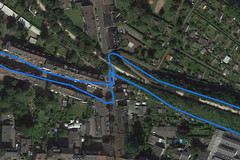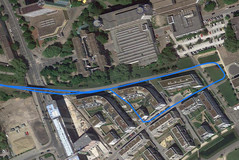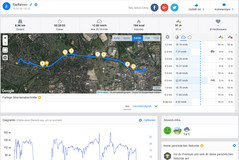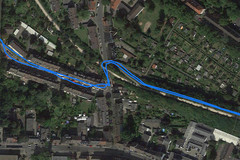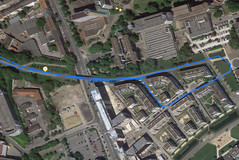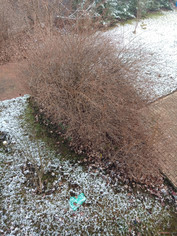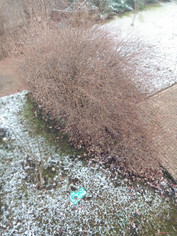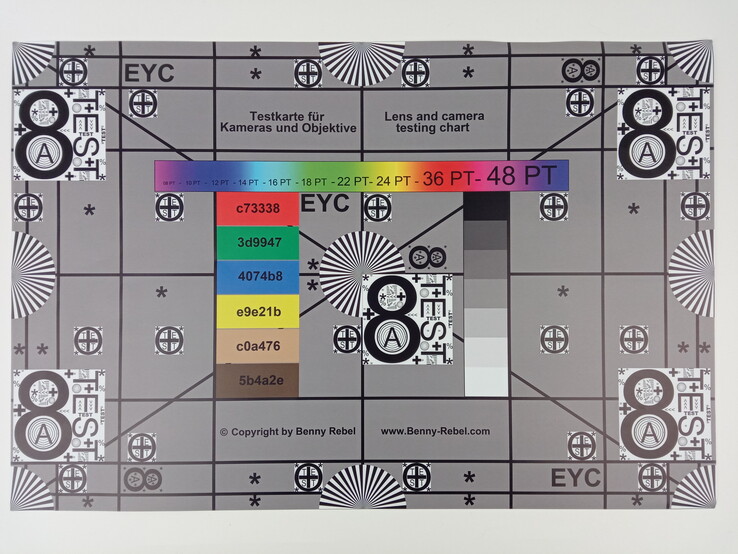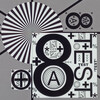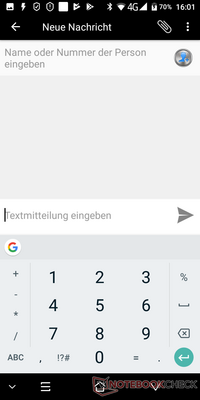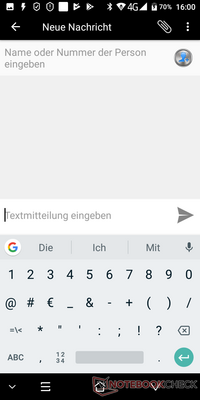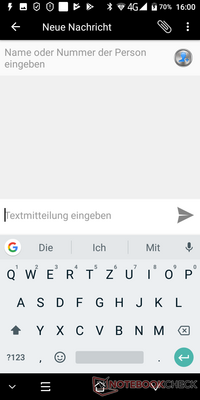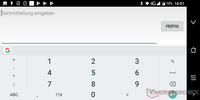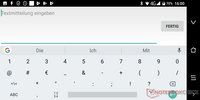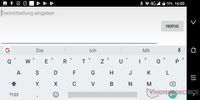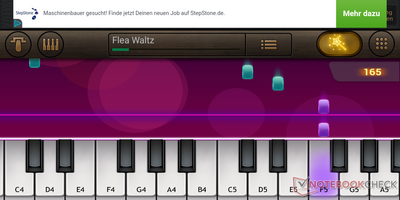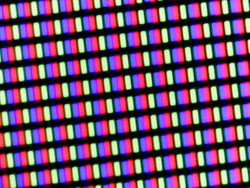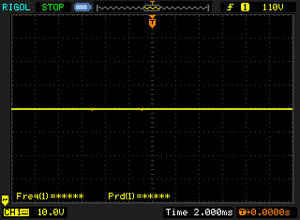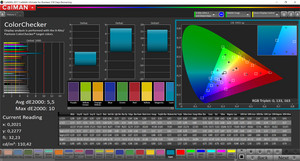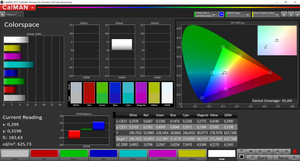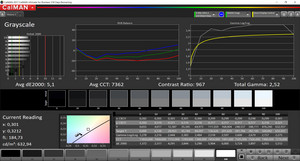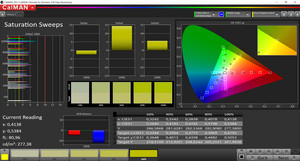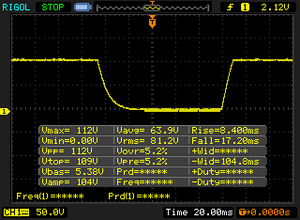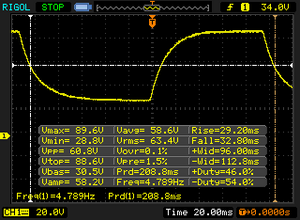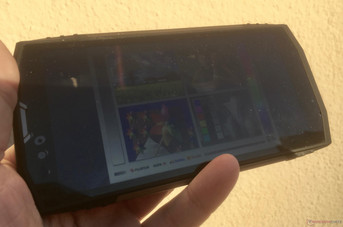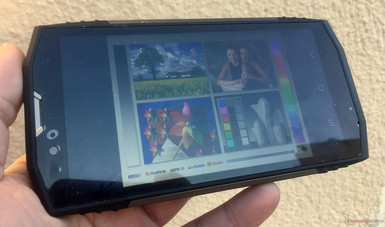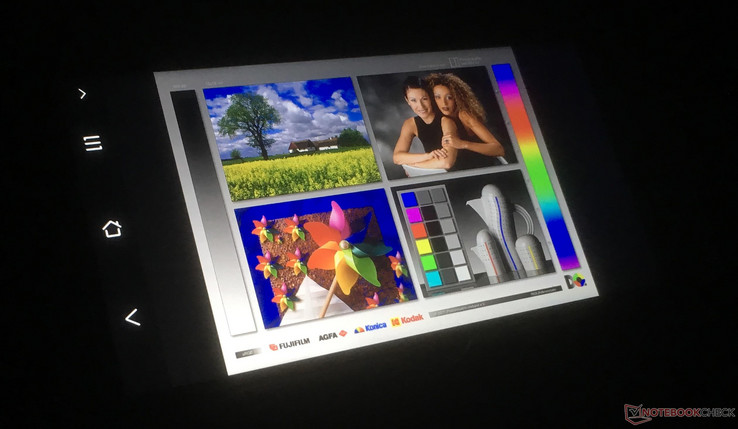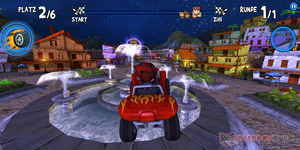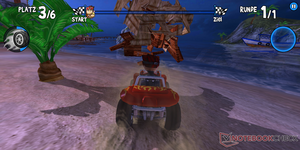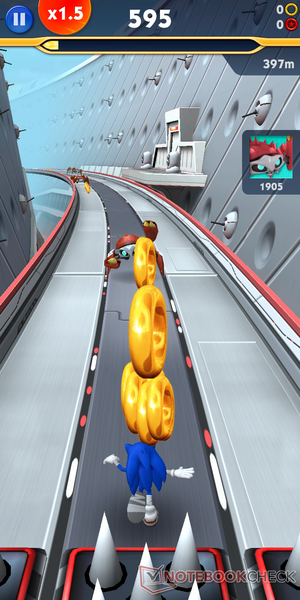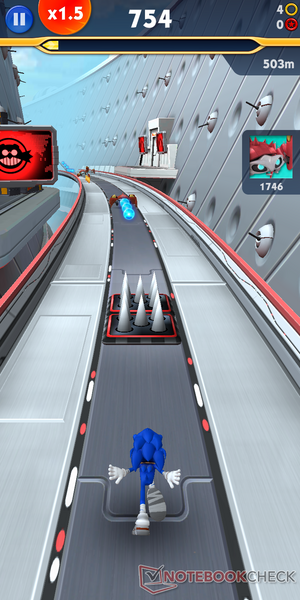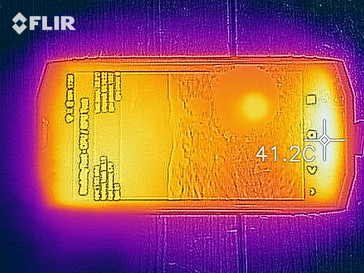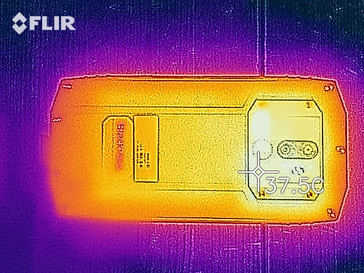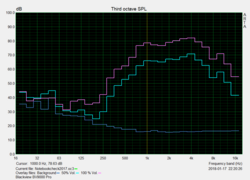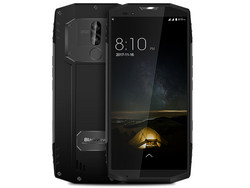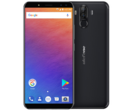Blackview BV9000 Pro Smartphone Review

Blackview has not yet given up on the outdoor smartphone market. The BV8000 Pro failed to take off due to some annoying software bugs, particularly a flickering display that has since been addressed by a software update and focusing issues on the main camera. These two flaws ruined its final score, but Blackview is back once more and has improved upon these points of criticism. The camera now features a 13 MP dual lens, and internal storage has been doubled. At 5.7-inches, the display is now slightly larger than before albeit its resolution is lower for some reason, and at its heart the microprocessor has been upgraded to the faster MediaTek Helio P25 (MT6757). The ARM Mali T880 MP2 GPU remained the same.
We found it pretty difficult to find similar smartphones to compare the BV9000 to, other than last year’s BV8000 Pro: Most rugged outdoor smartphones in our database are rather exotic offerings, to say the least. Thus, we had to narrow our list down to the Caterpillar-certified CAT S31 and the Doogee Mix. The latter is not a rugged outdoor smartphone by any means, but its internal hardware is largely identical to the BV9000. As such, it is ideal for performance comparisons.
Case
You can tell the BV9000 is extremely robust simply by looking at it. Large visible screws on all sides of the case ensure that everything stays in place at all times. Massive and almost exuberant applications of surplus material further serve to reinforce this initial impression. Consequently, untrained arms and hands will find it all but impossible to twist and warp this phone at all. The price for all this rigidity: more than half a pound of heft that will require large pockets. One-handed operation is not only hampered by the not particularly uncommon large display but also by the device’s thickness and bulkiness. The inevitable result of this is that outdoor enthusiasts and members of the outside workforce, for whom this phone is intended, will have a hard time fitting it in their pockets. On the plus side, design and build quality are spot on, a feat that is somewhat ruined by the fact that we found scratches on the display after just a few days of testing.
As expected from a phone that is supposed to be completely water and dust-proof, the battery is not user-replaceable. A noteworthy change from the older BV8000 Pro design: The SIM and microSD slot are no longer hidden behind a flap secured with screws. Instead, they are now protected by a rubber flap above the speaker grille. Granted, it does make accessing both cards much easier but we have to admit that the older design left us feeling more secure and confident in the peace-of-mind department after the phone had been submerged in a bucket of water.
Connectivity
Blackview did not skimp on memory and internal hardware. Both the RAM and storage memory are more than plentiful (6 GB and 128 GB, respectively), although we wonder whether the rather slow MediaTek Helio P25 processor will be capable of fully utilizing the massive amount of RAM at its disposal. When hunting for the GPU, Blackview decided to take one from the bottom of the shelf as the ARM Mali T880 has already been used in last year’s model. On the other hand, it is still powerful enough and therefore not necessarily a drawback, especially considering the even weaker and slower GPUs its competitors are equipped with.
The BV9000 features a total of six different sensors: accelerometer, magnetometer, attitude sensor, gyroscope, ambient light sensor, and proximity sensor. The barometer that was present in the BV8000 Pro is now missing.
As usual, connectivity is limited to the bare minimum: a single USB port with support for USB-OTG. In order to ensure water and dust-resistance, it is protected by a rubber flap similar to the one used for the SIM slot. This leads to a somewhat shallow full-width insertion depth and could in theory conflict with wider cables. Fortunately, the manufacturer has thought this through and an adapter is included in the box.
Blackview claims complete dust and water-resistance, which - of course - we had to test ourselves. As can be seen in the photo above we can confirm that it had absolutely no issues with complete submersion in water.
Software
The BV9000 Pro runs Android 7.1 out of the box, with Android security patches as of November 2017 and thus still acceptable at the time of review. A quick scan with Kaspersky Internet Security revealed no malware infection whatsoever. Luckily, Chinese manufacturers have finally figured out how to produce smartphones without ad- and bloatware, and the only extra apps we were able to locate on our review unit besides Google’s default apps were a compass app, an app called “Cell-Broadcast”, the Facemoji keyboard, and some tools relevant for utilizing hardware features such as the built-in radio or the flashlight. Some apps can be uninstalled (such as for example the aforementioned compass app), some cannot (the Facemoji keyboard).
In addition, Blackview has once again updated its icons for Android’s default applications. They are now round and metallic, as can be seen on the screenshots below. In some cases, this design language can also be found in the applications themselves, for example in the telephone or settings app. This apparent theme modification aside the Android operating system has been left largely untouched and unmodified.
Communication and GPS
The same can be said about the device’s communication modules. In addition to the 802.11 n Wi-Fi modem that is fairly common for cheap Chinese brands these days, the BV9000 Pro also supports Bluetooth 4.1 and NFC. It has become slightly faster than before, but the differences were within margin of error.
All relevant European GSM frequencies and LTE bands are supported.
| Networking | |
| iperf3 transmit AX12 | |
| Doogee Mix | |
| Blackview BV9000 Pro | |
| Blackview BV8000 Pro | |
| CAT S31 | |
| Samsung Galaxy XCover 4 | |
| iperf3 receive AX12 | |
| Blackview BV9000 Pro | |
| Blackview BV8000 Pro | |
| Doogee Mix | |
| Samsung Galaxy XCover 4 | |
| CAT S31 | |
The GPS modem is usually of particular interest for outdoor enthusiasts and thus the BV9000 Pro’s target audience, and a dust and water-proof rugged outdoor smartphone is predestined to be used in rough and wet conditions, for example as a bicycle GPS. The BV8000 Pro did very well in this test last year, and the BV9000 Pro followed in its predecessor’s footsteps and did not disappoint either. Location lock is obtained very quickly and accurately. Indoor accuracy was measured at 5 m - many phones fail to achieve this level of accuracy outdoors! Outdoor accuracy was even better, at only 2-3 m. The device supports GPS and GLONASS.
In our test competing against a professional Garmin Edge 500 GPS we found these accuracy indicators to be, well, accurate. For what we think is the first time ever, the smartphone used in this test was more accurate than the Garmin reference unit. Recorded distance travelled was virtually identical between the two devices, and the Garmin results seem to be a lot choppier than the BV9000 Pro’s. Thus, we can safely conclude that our review unit was equipped with a similarly accurate and excellent GPS unit as its own predecessor, and it makes for an amazing outdoor GPS device.
Telephony and Call Quality
As already mentioned, the BV9000 Pro uses a slightly modified version of Google’s default telephone app for all its telephony needs and services, and it worked quite well by and large. Our conversational partners were easily understandable and had no trouble understanding us either. Static was nonexistent on both ends of the line, and the volume was high enough thanks to the fact that the Blackview smartphone can get incredibly loud.
Our only gripe was that the phone itself felt rather clumsy and bulky when held in the hand for prolonged periods of time.
Cameras
Compared to its predecessor, the camera’s resolution has been reduced from 16 to 13 MP. However, the BV9000 Pro features a dual-camera sporting an extra 5 MP lens used for additional depth-of-field information and calculation. This extra lens is capable of producing amazing results, particularly in macro and close-up mode, and the resulting photos are very close to what a DSLR would be capable of. Aforementioned focus issues that were introduced on the BV8000 Pro following a software update were not present on our review unit at all. Overall, the cameras are decent but have failed to impress us. Colors are pale on both the front and the main shooter. Focus is decent as well; however, the camera is unable to keep up with the iPhone X or an actual DSLR. This becomes particularly evident under low-light conditions, where photos lose focus and turn out increasingly blurry instead.
The aperture can be adjusted to a certain extent, affecting the camera app’s depth-of-field effect. The differences, however, were minimal.
Our subjective first impression was further confirmed under controlled conditions in our lab. Colors turned out pale and far from their respective reference. Black is closer to dark beige than actual black, which can be corrected by using professional photo-editing software. Focus was acceptable up close, yet at large the photos seem to be pretty blurry. All things considered, we would consider this camera to perform slightly below average. Fortunately, the days of horribly bad smartphone cameras are long gone.
Accessories and Warranty
A specialty of the Blackview BV9000 Pro is its recessed USB port that can be hard to reach with some thicker cables. The phone also lacks an audio jack, rendering the included headset seemingly useless at first glance. Fortunately, the required dongles are included in the box in addition to a SIM tool and a USB-OTG cable.
Please read our notes on warranty and CE conformity regarding devices sold and shipped directly from China. As we speak, Blackview does not offer any sort of warranty at all, and potential buyers are thus restricted to seller warranty.
Please see our Guarantees, Return Policies and Warranties FAQ for country-specific information.
Input Devices & Handling
The extra hardware button on the right-hand side is user-programmable and can be used for various predefined tasks, for example for taking a photo. Unfortunately, this particular feature has not been thought and designed all the way through: While we were able to launch the camera app by pressing the button it did not act as a shutter button once the app was launched.
The preloaded keyboard application is Google’s default keyboard with Google’s multilingual Gboard app coming preloaded on the device as well.
The 5-point multitouch-capable screen turned out to be somewhat problematic. Running Gismart Real Piano we were unable to play the “Der Flohwalzer” (the "Flea Waltz") without short breaks in-between due to the screen’s failure to occasionally detect input at the bottom left corner. The rest of the screen worked flawlessly, and response times were reasonably fast in case input was detected.
The fingerprint reader sits at the back of the phone, and it is capable of waking up the phone from standby and unlocking it virtually instantaneously. Its position at the rear is far from perfect though: We did encounter occasional accidental triggering with other fingers resulting in too many failed unlock attempts and the necessity to put in the security code instead.
While playing Beach Buggy Racing the attitude sensor worked flawlessly and responded quickly. We had no trouble steering the vehicle, and there were no inconsistencies either (re: touch screen input detection problems).
Display
Blackview’s own information on the display is highly inconsistent. On the phone’s website, the display is initially listed as an 18:9 display running at 1080x2160, immediately followed by an alleged display resolution of 1440x720 on the exact same page. We find the latter to be much more believable since both AIDA64 and CPU-Z seem to agree on the lower display resolution and the screenshots we took during the review were saved with that exact resolution as well. Thus, the 2:1 display’s resolution is lower than it was on the previous model, which featured an FHD display. We should thus be able to identify individual pixels on the display when magnified. However, at the end of the day pixel densities far beyond the human eye’s level of perceptibility are of less concern in an outdoor smartphone than display brightness, and in this regard the BV9000 has managed to impress us. Not only does it literally outshine its own predecessor, it also bests the entire competition save for the CAT S31, whose unbelievable maximum brightness of 750 nits is the highest ever recorded by us on a smartphone display.
| |||||||||||||||||||||||||
Brightness Distribution: 91 %
Center on Battery: 621 cd/m²
Contrast: 970:1 (Black: 0.64 cd/m²)
ΔE ColorChecker Calman: 5.5 | ∀{0.5-29.43 Ø4.77}
ΔE Greyscale Calman: 5.1 | ∀{0.09-98 Ø5}
Gamma: 2.52
CCT: 7362 K
| Blackview BV9000 Pro IPS, 1440x720, 5.7" | Blackview BV8000 Pro IPS, 1920x1080, 5" | Samsung Galaxy XCover 4 IPS, 1280x720, 5" | CAT S31 IPS, 1280x720, 4.7" | Doogee Mix AMOLED, 1280x720, 5.5" | |
|---|---|---|---|---|---|
| Screen | -45% | -20% | 22% | -11% | |
| Brightness middle (cd/m²) | 621 | 434 -30% | 445 -28% | 784 26% | 358 -42% |
| Brightness (cd/m²) | 598 | 414 -31% | 437 -27% | 750 25% | 354 -41% |
| Brightness Distribution (%) | 91 | 86 -5% | 88 -3% | 92 1% | 90 -1% |
| Black Level * (cd/m²) | 0.64 | 0.64 -0% | 0.67 -5% | 0.45 30% | |
| Contrast (:1) | 970 | 678 -30% | 664 -32% | 1742 80% | |
| Colorchecker dE 2000 * | 5.5 | 9.8 -78% | 6.5 -18% | 4.28 22% | 4.9 11% |
| Colorchecker dE 2000 max. * | 10 | 19.2 -92% | 10.6 -6% | 8.75 12% | 11.8 -18% |
| Greyscale dE 2000 * | 5.1 | 9.9 -94% | 7.2 -41% | 6.1 -20% | 3.9 24% |
| Gamma | 2.52 87% | 2.64 83% | 2.53 87% | 2.49 88% | 2.33 94% |
| CCT | 7362 88% | 9219 71% | 8274 79% | 7175 91% | 7260 90% |
* ... smaller is better
Screen Flickering / PWM (Pulse-Width Modulation)
| Screen flickering / PWM not detected | |||
In comparison: 53 % of all tested devices do not use PWM to dim the display. If PWM was detected, an average of 8083 (minimum: 5 - maximum: 343500) Hz was measured. | |||
Brightness aside, the display did fairly well overall. While the CAT S31 turned out to be brighter it is also 50 Euros (~$61) more expensive and incapable of keeping up with the BV9000 in regard to performance. As such, the BV9000 Pro’s display was conspicuously inconspicuous. DeltaE deviations were okay overall, with a slight blue tint for grayscales detected by CalMAN but invisible to the naked eye. We strongly assume that the BV9000 Pro’s target audience will not be particularly interested in color accuracy and AdobeRGB coverage, except for maybe the odd graphic designer based in Nepal. Thus, the display is perfectly suited for its intended use case.
Display Response Times
| ↔ Response Time Black to White | ||
|---|---|---|
| 25.6 ms ... rise ↗ and fall ↘ combined | ↗ 8.4 ms rise | |
| ↘ 17.2 ms fall | ||
| The screen shows relatively slow response rates in our tests and may be too slow for gamers. In comparison, all tested devices range from 0.1 (minimum) to 240 (maximum) ms. » 60 % of all devices are better. This means that the measured response time is worse than the average of all tested devices (20.2 ms). | ||
| ↔ Response Time 50% Grey to 80% Grey | ||
| 62 ms ... rise ↗ and fall ↘ combined | ↗ 29.2 ms rise | |
| ↘ 32.8 ms fall | ||
| The screen shows slow response rates in our tests and will be unsatisfactory for gamers. In comparison, all tested devices range from 0.165 (minimum) to 636 (maximum) ms. » 97 % of all devices are better. This means that the measured response time is worse than the average of all tested devices (31.6 ms). | ||
The display is easily and readily usable outdoors thanks to its high maximum brightness. It remained readable even in direct sunlight and is thus almost destined to become a bicycle GPS unit. If an even brighter display is required we suggest taking a closer look at the CAT S31.
Performance
Generally speaking, performance was on the low side and comparable to the similarly or identically equipped BV8000 Pro and Doogee Mix but much faster than the inferior Samsung XCover or CAT S31. Both the Doogee Mix and the BV9000 Pro are equipped with the same MediaTek Helio P25 CPU and an ARM Mali T880 GPU. The BV8000 Pro features an older Helio P20 CPU by MediaTek, which is very similar to the P25 by and large.
The BV9000 Pro did very well in benchmarks that depended heavily on the CPU. In return, it showed significant weaknesses in GPU and storage performance. It even had to succumb to its predecessor in pretty much every 3DMark benchmark despite the older model’s higher display resolution. The Doogee Mix performed better in these tests and seems to handle its hardware more efficiently.
| AnTuTu v6 - Total Score (sort by value) | |
| Blackview BV9000 Pro | |
| Blackview BV8000 Pro | |
| Samsung Galaxy XCover 4 | |
| CAT S31 | |
| Doogee Mix | |
| PCMark for Android | |
| Work performance score (sort by value) | |
| Blackview BV9000 Pro | |
| Blackview BV8000 Pro | |
| Samsung Galaxy XCover 4 | |
| CAT S31 | |
| Doogee Mix | |
| Work 2.0 performance score (sort by value) | |
| Blackview BV9000 Pro | |
| Blackview BV8000 Pro | |
| Samsung Galaxy XCover 4 | |
| CAT S31 | |
| Doogee Mix | |
| Geekbench 4.4 | |
| 64 Bit Single-Core Score (sort by value) | |
| Blackview BV9000 Pro | |
| Blackview BV8000 Pro | |
| Samsung Galaxy XCover 4 | |
| CAT S31 | |
| Doogee Mix | |
| 64 Bit Multi-Core Score (sort by value) | |
| Blackview BV9000 Pro | |
| Blackview BV8000 Pro | |
| Samsung Galaxy XCover 4 | |
| CAT S31 | |
| Doogee Mix | |
| Compute RenderScript Score (sort by value) | |
| Blackview BV9000 Pro | |
| Blackview BV8000 Pro | |
| Doogee Mix | |
| GFXBench (DX / GLBenchmark) 2.7 | |
| T-Rex Onscreen (sort by value) | |
| Blackview BV9000 Pro | |
| Samsung Galaxy XCover 4 | |
| CAT S31 | |
| Doogee Mix | |
| 1920x1080 T-Rex Offscreen (sort by value) | |
| Blackview BV9000 Pro | |
| Samsung Galaxy XCover 4 | |
| CAT S31 | |
| Doogee Mix | |
| GFXBench 3.0 | |
| on screen Manhattan Onscreen OGL (sort by value) | |
| Blackview BV9000 Pro | |
| Blackview BV8000 Pro | |
| Samsung Galaxy XCover 4 | |
| CAT S31 | |
| Doogee Mix | |
| 1920x1080 1080p Manhattan Offscreen (sort by value) | |
| Blackview BV9000 Pro | |
| Blackview BV8000 Pro | |
| Samsung Galaxy XCover 4 | |
| CAT S31 | |
| Doogee Mix | |
| GFXBench 3.1 | |
| on screen Manhattan ES 3.1 Onscreen (sort by value) | |
| Blackview BV9000 Pro | |
| Blackview BV8000 Pro | |
| Samsung Galaxy XCover 4 | |
| Doogee Mix | |
| 1920x1080 Manhattan ES 3.1 Offscreen (sort by value) | |
| Blackview BV9000 Pro | |
| Blackview BV8000 Pro | |
| Samsung Galaxy XCover 4 | |
| Doogee Mix | |
| GFXBench | |
| on screen Car Chase Onscreen (sort by value) | |
| Blackview BV9000 Pro | |
| Blackview BV8000 Pro | |
| Doogee Mix | |
| 1920x1080 Car Chase Offscreen (sort by value) | |
| Blackview BV9000 Pro | |
| Blackview BV8000 Pro | |
| Doogee Mix | |
| Lightmark - 1920x1080 1080p (sort by value) | |
| Samsung Galaxy XCover 4 | |
| Doogee Mix | |
| Basemark X 1.1 | |
| Medium Quality (sort by value) | |
| Samsung Galaxy XCover 4 | |
| Doogee Mix | |
| High Quality (sort by value) | |
| Samsung Galaxy XCover 4 | |
| Doogee Mix | |
| Basemark ES 3.1 / Metal - offscreen Overall Score (sort by value) | |
| Samsung Galaxy XCover 4 | |
| Doogee Mix | |
| Epic Citadel - Ultra High Quality (sort by value) | |
| Samsung Galaxy XCover 4 | |
| Doogee Mix | |
Browser performance is highly inconsistent, with the BV9000 Pro trumping the JetStream benchmark yet falling behind even the CAT S31 in the Kraken benchmark.
| JetStream 1.1 - Total Score | |
| Blackview BV9000 Pro (Chrome Mobile 53) | |
| Doogee Mix (Chrome 60) | |
| Blackview BV8000 Pro (Crome Version 51) | |
| Samsung Galaxy XCover 4 (Chrome 58) | |
| CAT S31 | |
| Octane V2 - Total Score | |
| Doogee Mix (Chrome 60) | |
| Blackview BV9000 Pro (Chrome Mobile 53) | |
| Blackview BV8000 Pro (Crome Version 51) | |
| Samsung Galaxy XCover 4 (Chrome 58) | |
| CAT S31 | |
| Mozilla Kraken 1.1 - Total | |
| Blackview BV8000 Pro (Crome Version 51) | |
| CAT S31 | |
| Blackview BV9000 Pro (Chrome Mobile 53) | |
| Samsung Galaxy XCover 4 (Chrome 58) | |
| Doogee Mix (Chrome 60) | |
| WebXPRT 2015 - Overall | |
| Doogee Mix (Chrome 60) | |
| Samsung Galaxy XCover 4 (Chrome 58) | |
* ... smaller is better
Storage performance is almost identical on the BV9000 Pro and the BV8000 Pro, and it seems like Blackview has opted for the exact same memory chips on both models. The same can be said for the memory card reader: When benchmarked with our Toshiba Exceria M501 reference card both smartphones achieved virtually identical results. While storage can be expanded via microSD card, it is questionable whether or not this will ever be necessary thanks to the device’s 128 GB of onboard storage (110 GB user-accessible).
| Blackview BV9000 Pro | Blackview BV8000 Pro | Samsung Galaxy XCover 4 | CAT S31 | Doogee Mix | |
|---|---|---|---|---|---|
| AndroBench 3-5 | -1% | -32% | -34% | -3% | |
| Sequential Read 256KB (MB/s) | 244.7 | 246.4 1% | 181.6 -26% | 71.1 -71% | 249 2% |
| Sequential Write 256KB (MB/s) | 174.6 | 177.1 1% | 73.6 -58% | 62.1 -64% | 165 -5% |
| Random Read 4KB (MB/s) | 72.6 | 52.7 -27% | 21.8 -70% | 14.28 -80% | 66.5 -8% |
| Random Write 4KB (MB/s) | 12.72 | 15.05 18% | 11.9 -6% | 14.81 16% | 11.2 -12% |
| Sequential Read 256KB SDCard (MB/s) | 76.7 ? | 79.3 ? 3% | 69 ? -10% | 81.8 7% | 78 ? 2% |
| Sequential Write 256KB SDCard (MB/s) | 68.5 ? | 68.7 ? 0% | 55.7 ? -19% | 59.5 -13% | 69.4 ? 1% |
Gaming
We ran extensive tests playing Beach Buggy Racing, which served as benchmark for both graphics performance and the attitude sensor’s capabilities. The game ran very smoothly with default graphics settings, and the attitude sensor worked flawlessly as well. We started to notice slight stuttering at maximum details, and it only serves to prove our point: The ARM Mali T880 is no more than an aged lower mid-range GPU at best. On the other hand, most games in Google’s Play Store are aimed specifically at this level of performance.
Emissions
Temperature
Surface temperatures are slightly different from what we came to expect from a smartphone thanks to its robust and exuberant packaging. This was already the case with the BV8000 Pro, which kept its average surface temperatures only slightly above body temperature. Without being any faster, the newer model is around 4-6 °F (2-3 °C) warmer. We must admit that we were a little bit disappointed, but overall this certainly cannot be considered a downside per se.
(±) The maximum temperature on the upper side is 41.7 °C / 107 F, compared to the average of 35.2 °C / 95 F, ranging from 21.9 to 247 °C for the class Smartphone.
(+) The bottom heats up to a maximum of 38.3 °C / 101 F, compared to the average of 34 °C / 93 F
(±) In idle usage, the average temperature for the upper side is 33.6 °C / 92 F, compared to the device average of 32.9 °C / 91 F.
Speakers
Another aspect where the older model beats its own successor is speaker performance, where the head-to-head comparison between the BV8000 and BV9000 reveals the older model’s all-out superiority.
The only feature where the BV9000 manages to differentiate itself from its competitors is maximum volume: It gets really loud when you crank up the volume! Other than that, the speakers are nothing to write home about: almost no bass, decent highs, acceptable mids. That’s really all there is to say.
Blackview BV9000 Pro audio analysis
(+) | speakers can play relatively loud (90.3 dB)
Bass 100 - 315 Hz
(-) | nearly no bass - on average 30.5% lower than median
(±) | linearity of bass is average (8.8% delta to prev. frequency)
Mids 400 - 2000 Hz
(±) | higher mids - on average 6.9% higher than median
(+) | mids are linear (6.7% delta to prev. frequency)
Highs 2 - 16 kHz
(±) | higher highs - on average 6.8% higher than median
(+) | highs are linear (5.7% delta to prev. frequency)
Overall 100 - 16.000 Hz
(±) | linearity of overall sound is average (24.7% difference to median)
Compared to same class
» 59% of all tested devices in this class were better, 7% similar, 34% worse
» The best had a delta of 11%, average was 35%, worst was 134%
Compared to all devices tested
» 75% of all tested devices were better, 5% similar, 20% worse
» The best had a delta of 4%, average was 24%, worst was 134%
Blackview BV8000 Pro audio analysis
(+) | speakers can play relatively loud (92 dB)
Bass 100 - 315 Hz
(-) | nearly no bass - on average 28.2% lower than median
(+) | bass is linear (4% delta to prev. frequency)
Mids 400 - 2000 Hz
(±) | reduced mids - on average 5.3% lower than median
(+) | mids are linear (6.2% delta to prev. frequency)
Highs 2 - 16 kHz
(+) | balanced highs - only 2.4% away from median
(+) | highs are linear (2.7% delta to prev. frequency)
Overall 100 - 16.000 Hz
(±) | linearity of overall sound is average (18.6% difference to median)
Compared to same class
» 21% of all tested devices in this class were better, 9% similar, 70% worse
» The best had a delta of 11%, average was 35%, worst was 134%
Compared to all devices tested
» 41% of all tested devices were better, 8% similar, 51% worse
» The best had a delta of 4%, average was 24%, worst was 134%
Samsung Galaxy XCover 4 audio analysis
(±) | speaker loudness is average but good (80.4 dB)
Bass 100 - 315 Hz
(-) | nearly no bass - on average 15.9% lower than median
(±) | linearity of bass is average (12.3% delta to prev. frequency)
Mids 400 - 2000 Hz
(±) | higher mids - on average 7.4% higher than median
(+) | mids are linear (5.1% delta to prev. frequency)
Highs 2 - 16 kHz
(±) | higher highs - on average 6.3% higher than median
(+) | highs are linear (6.3% delta to prev. frequency)
Overall 100 - 16.000 Hz
(±) | linearity of overall sound is average (24.2% difference to median)
Compared to same class
» 56% of all tested devices in this class were better, 7% similar, 36% worse
» The best had a delta of 11%, average was 35%, worst was 134%
Compared to all devices tested
» 72% of all tested devices were better, 6% similar, 22% worse
» The best had a delta of 4%, average was 24%, worst was 134%
CAT S31 audio analysis
(±) | speaker loudness is average but good (76.9 dB)
Bass 100 - 315 Hz
(-) | nearly no bass - on average 21.7% lower than median
(±) | linearity of bass is average (7.8% delta to prev. frequency)
Mids 400 - 2000 Hz
(±) | higher mids - on average 7% higher than median
(+) | mids are linear (6.8% delta to prev. frequency)
Highs 2 - 16 kHz
(±) | higher highs - on average 6.5% higher than median
(+) | highs are linear (4% delta to prev. frequency)
Overall 100 - 16.000 Hz
(±) | linearity of overall sound is average (26.6% difference to median)
Compared to same class
» 68% of all tested devices in this class were better, 5% similar, 27% worse
» The best had a delta of 11%, average was 35%, worst was 134%
Compared to all devices tested
» 81% of all tested devices were better, 4% similar, 15% worse
» The best had a delta of 4%, average was 24%, worst was 134%
Doogee Mix audio analysis
(±) | speaker loudness is average but good (81.8 dB)
Bass 100 - 315 Hz
(-) | nearly no bass - on average 38.6% lower than median
(±) | linearity of bass is average (8.3% delta to prev. frequency)
Mids 400 - 2000 Hz
(+) | balanced mids - only 4% away from median
(±) | linearity of mids is average (8.2% delta to prev. frequency)
Highs 2 - 16 kHz
(+) | balanced highs - only 4% away from median
(+) | highs are linear (5.1% delta to prev. frequency)
Overall 100 - 16.000 Hz
(±) | linearity of overall sound is average (27.4% difference to median)
Compared to same class
» 71% of all tested devices in this class were better, 5% similar, 24% worse
» The best had a delta of 11%, average was 35%, worst was 134%
Compared to all devices tested
» 83% of all tested devices were better, 4% similar, 13% worse
» The best had a delta of 4%, average was 24%, worst was 134%
Frequency diagram (checkboxes selectable/deselectable!)
Battery Life
Power Consumption
Despite identical battery capacity the BV9000 Pro’s power consumption was around 20% higher than the BV8000 Pro’s, most likely due to its bigger and brighter display. The results look even worse when compared to the BV9000 Pro’s rivals. As before, the included charger is fairly powerful and capable of recharging the phone in less than two hours.
| Off / Standby | |
| Idle | |
| Load |
|
Key:
min: | |
| Blackview BV9000 Pro 4180 mAh | Blackview BV8000 Pro 4180 mAh | Samsung Galaxy XCover 4 2800 mAh | CAT S31 4000 mAh | Doogee Mix 3360 mAh | |
|---|---|---|---|---|---|
| Power Consumption | 14% | 23% | 20% | 20% | |
| Idle Minimum * (Watt) | 1.04 | 0.85 18% | 0.56 46% | 0.73 30% | 1.13 -9% |
| Idle Average * (Watt) | 2.14 | 1.56 27% | 1.57 27% | 2.21 -3% | 1.7 21% |
| Idle Maximum * (Watt) | 2.17 | 1.67 23% | 1.68 23% | 2.25 -4% | 1.74 20% |
| Load Average * (Watt) | 5.11 | 4.37 14% | 4.6 10% | 2.99 41% | 2.78 46% |
| Load Maximum * (Watt) | 6.37 | 7.06 -11% | 5.92 7% | 4.12 35% | 5.01 21% |
* ... smaller is better
Battery Life
No surprises here: Blackview has failed to improve upon battery life. Despite its identical capacity the BV9000 Pro falls behind its own predecessor, and it is barely capable of keeping up with the Samsung XCover (whose battery is only two-thirds the size of the BV9000’s). This can be partly explained with the BV9000’s bigger and, more importantly, brighter display. On the other side, the even brighter CAT S31 is living proof that a bright display does not necessarily have to result in shorter battery life.
| Blackview BV9000 Pro 4180 mAh | Blackview BV8000 Pro 4180 mAh | Samsung Galaxy XCover 4 2800 mAh | CAT S31 4000 mAh | Doogee Mix 3360 mAh | |
|---|---|---|---|---|---|
| Battery runtime | 43% | 3% | 85% | -1% | |
| Reader / Idle (h) | 19 | 26.3 38% | 23.1 22% | ||
| WiFi v1.3 (h) | 9.7 | 11.5 19% | 11.1 14% | 17.9 85% | 9.6 -1% |
| Load (h) | 4.6 | 7.9 72% | 3.4 -26% | ||
| H.264 (h) | 11.4 |
Pros
Cons
Verdict
Our verdict is best served as direct comparison between the two Blackview smartphones. Long story short: If not for its camera’s focusing issues, the BV8000 Pro would be the superior smartphone in almost all regards. More specifically, this means that the newer version is not really any faster than the older one despite its updated processor. The newer model’s display resolution is lower, and it is around 50 Euros (~$61) more expensive to boot.
The only areas of improvement are the brighter display and the internal storage that has been doubled in size. Thus, before purchasing the BV9000 Pro we would recommend trying to figure out whether or not Blackview has managed to address and fix the BV8000 Pro’s focusing issues first.
Decent overall package with only minor deficiencies yet somehow still inferior to its own predecessor.
At the end of the day it is all a moot point given the predecessor’s critical flaw that has seemingly been addressed by Blackview in the BV9000 Pro.
The BV9000 Pro certainly is a very robust smartphone. All things considered it worked as expected even if it turned out to be slightly slower than hoped for. These minor slowdowns should be completely unnoticeable in everyday use, and we have failed to find anything even remotely comparable at the BV9000 Pro’s cross point of price and performance.
The only hindrance for its target audience could be the BV9000 Pro’s massive size and heft, and if that turns out to be the case the CAT S31 might be the better choice. It is smaller and, more importantly, brighter - two critical criteria for any rugged smartphone. But as always at the end of the day it boils down to personal preference.
If you are satisfied with the BV9000 Pro’s level of performance and happen to be in the market for a rugged smartphone and are not particularly concerned by its size and weight, the BV9000 Pro might be the perfect smartphone for you.
Blackview BV9000 Pro
- 02/07/2018 v6 (old)
Florian Schaar


